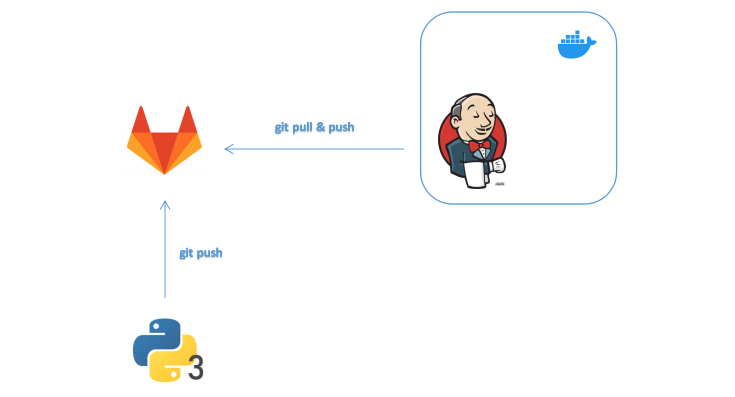Overview
This blog shows you one of the Jenkins Pipeline examples in a practical automation project.
It is for anyone who wants to know how to apply Jenkins Pipeline to an automation project. Or if you are new to Jenkins and want to get your hands dirty practicing on it, then this post is for you.
The blog post does not explain docker in depth but you can visit some reference links for details. Instead, it focuses on configuring Jenkins job and parallel testing with a single file across multiple processes.
And it is designed to work on Windows 10 Pro only, not on a macOS or Linux machine.
Before continuing, ensure you have installed the following tools
- Docker
You can install the latest version of Docker Desktop which contains both Docker and Docker-Compose tools
ref: download link - GitLab
During the steps, you will be required to download/upload the source code to GitLab. Ensure you have installed and configured Git and authentication to your GitLab
Jenkins Server Startup
The steps in this part will do the following
- download Jenkins docker image
- install Docker Pipeline plugin in Jenkins server
- perform initial configuration for Jenkins
The plugin is required for using docker.image in Scripted Pipeline. When the Pipeline executes, Jenkins will automatically start the specified container and execute the defined steps within it.
If you are currently working from home, VPN connection may prevent installing Jenkins plugins. Please consider to disconnect VPN temporarily before continuing the next steps.
Jenkinsfile (Scripted Pipeline)
node {
/* Requires the Docker Pipeline plugin to be installed */
stage('Test') {
docker.image('python:3.6.8-alpine').inside {
sh 'python --version'
}
}
}ref: Using Docker with Pipeline
Now please follow the next step-by-step
-
Run Docker Desktop

-
Run Jenkins in Docker Container
Refer to the official Jenkins document to follow step# 1-6 on Windows. Or to keep it simple and avoid typo, you can use docker-compose tool with only 2 commandsdocker-compose buildanddocker-compose up -dinside project root folder. You will need to download source code from GitLab repository (*the link is TBD) first.
ref: create docker-compose
Two ways above are equivalent to start up Jenkins in Docker.- When doing Create First Admin User then select Skip and continue as admin

- And in the remaining screens, select option as default (blue highlight)
- When doing Create First Admin User then select Skip and continue as admin
-
Then Welcome screen is displayed
-
Change password using Configure button

-
Log in again with a new password
-
Then Welcome screen is displayed again

Create & Configure Pipeline Job
The steps in this part will create the first Jenkins Pipeline job and configure it to do the following
- download the latest source code from GitLab
- run test with current source code
- upload test result to GitLab
In the upcoming configuration, we will use an existing GitLab repository (*the link is TBD) which contains a simple Python test.
The function test_read_write_input_file focuses on reading and writing a single CSV file parallel. To achieve that goal, we will use pytest as test runner and pytest-xdist & filelock plugins.
The screenshot below demonstrates how to lock file with 2 processes (gw0 & gw1) parallel. Only one process can lock the file at a time. When the process gw0 unlock/release the file then only the process gw1 can lock it again.

In this test, only one function test_read_write_input_file is collected by pytest. We will run the test on every process by specifying the option --dist=each in pytest command. It means that the test is run twice parallel, one on gw0 and one on gw1.
The full command to run the test is pytest -n 2 --dist=each
You can change the number of processes and dist options in the command by referring the links as below.
ref: pytest-xdist, pytest-xdist options
Now please follow the next step-by-step
- Create a new item for Pipeline job

- Copy the script to pipeline definition and then save it
node {
stage('Download source code from Git') {
// the below will clone your repo and will be checked out to master branch by default
git credentialsId: 'auto-credentials', url: 'https://gitlab.shiftasia.com/thuanpham/jenkins-docker-sample.git', branch: 'master'
}
stage('Run Test') {
// download docker image with specific version
docker.image('python:3.6.8-alpine').inside {
// check Python version
sh 'python --version'
sh 'pip list'
withEnv(["HOME=${env.WORKSPACE}"]) {
// install libraries required for testing
sh 'pip install -r requirements.txt --user'
// check libraries installed
sh 'pip list'
// execute test
sh 'python -m pytest -n 2 --dist=each'
}
}
}
stage('Upload test result to Git') {
def file='input.csv'
sh 'git add '+file
sh '''git commit -m "Commit from Jenkins $(date +"%d-%m-%Y")" '''
withCredentials([usernamePassword(credentialsId: 'auto-credentials', passwordVariable: 'PASSWORD', usernameVariable: 'USERNAME')]) {
sh "git push https://'$USERNAME:$PASSWORD'@gitlab.shiftasia.com/thuanpham/jenkins-docker-sample.git master"
}
}
}
For pipeline syntax, click the link for details

You can generate the following command by using it
git credentialsId: 'auto-credentials', url: 'https://gitlab.shiftasia.com/thuanpham/jenkins-docker-sample.git'




- Access the docker container to configure Git
D:\projects\jenkins-docker-sample>docker exec -it jenkins-blueocean bash
jenkins@80a042ac8a34:/$ git config --list
jenkins@80a042ac8a34:/$ git config --global user.name "Jenkins"
jenkins@80a042ac8a34:/$ git config --global user.email "jenkins@test.com"
jenkins@80a042ac8a34:/$ git config --list
user.name=Jenkins
user.email=jenkins@test.com
jenkins@80a042ac8a34:/$ exit
exit
D:\projects\jenkins-docker-sample>
ref: access docker container by command
- Run the job
If you are currently working from home, VPN connection is required to run the job. The job will download source code from GitLab and upload file changes to it.

- Check the console log





- Check GitLab repository for the latest commit from Jenkins

- Stop Jenkins server by command
docker stop jenkins-blueocean jenkins-docker. Or if you are using docker-compose tool, please use the commanddocker-compose down
- Restart Jenkins server by the command
docker-compose up -d
That's all for the example, thanks for reading.
Enjoy!






